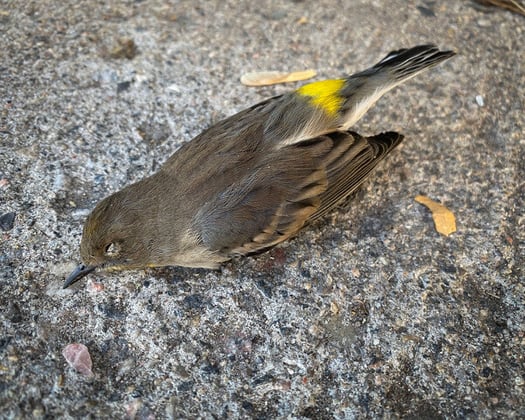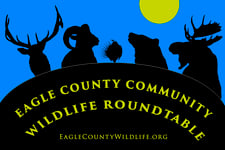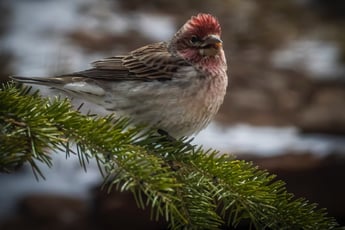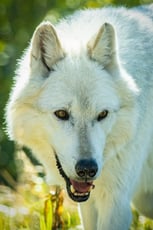Winter Bird Feeding
If you set out bird feeders, you are not alone. The US Fish and Wildlife Service estimates that...


Most of us love dogs and cats. I have one of each, and they are great companions and valued members of my family. But, unless we take a few simple precautions, house pets can have a significant negative impact on the natural environment.
Both cats and dogs are invasive species in Colorado. They are not part of our historic ecosystem. Cats and dogs were imported into Eagle County by humans in the relatively recent past. And, like their human owners, as their numbers have exploded so has their cumulative impact on the natural environment.
This article explores the ways domestic dogs and cats can negatively impact our local ecosystems and the simple steps that we, as pet guardians, can take to reduce adverse effects and keep our pets safe.
 Many wildlife areas and trails have dates that prohibit dogs during the nesting season for bird life.
Many wildlife areas and trails have dates that prohibit dogs during the nesting season for bird life.
It is important to remember that all dogs are descended from an ancient, now-extinct subspecies of wolves that appeared 30-40,000 years ago. Long-term association between this subspecies and human hunter-gatherers began more than 15,000 years ago.
Wolves have preyed on deer, elk, and smaller wildlife for thousands of years. Most species of wildlife still perceive dogs as predators. The presence of dogs, even when accompanied by humans, triggers a fear response in prey animals like deer, elk, and smaller mammals and rodents.
 Elk harassed by dogs in the winter may not get good nutrition and enough rest to survive through the winter.
Elk harassed by dogs in the winter may not get good nutrition and enough rest to survive through the winter.
Unleashed dogs sometimes kill or injure wildlife, especially their young. Pikas – perhaps Eagle County’s cutest high-altitude mammal - and other small animals like ground squirrels and chipmunks are particularly susceptible to being injured or killed by dogs. Being chased by a dog stresses wildlife, causing them to burn much-needed calories, and may cause pregnant wildlife to miscarry. Even if your dog doesn’t chase or catch wildlife, prey animals still perceive your dog as a threat, resulting in substantial harm, including:
Displacement: The presence of dogs (or even their lingering scent) causes wildlife to move away from an area, sometimes for extended periods, reducing available habitat in which they can feed, breed, and rest.
Stress: Even if not chased, prey animals are aware of your dog’s presence. This causes them stress, increases their heart rate and caloric needs, and interrupts their feeding. Similar to the effect of long-term stress on humans, repeated stress can increase wildlife’s vulnerability to disease, suppress their immune system, and reduce growth and chances of reproduction.
Disease: Dog poop can also carry parasites and bacteria that spread to wildlife and lead to sickness and death. Wildlife lacks the protection of vaccinations that your dog has. Humans can also catch parasites and diseases from dog poop, including hookworm, roundworms, and salmonella.
Ecological harm: Off-leash dogs disperse seeds from invasive plants, diminishing available food supplies and altering the natural ecology.
Owners of off-leash dogs are less likely to pick up their dog’s poop. But don’t all animals poop in the woods? They do, but not all poop is the same. Dogs don’t eat off the land like wild animals. Dog poop is much higher in nutrients, nitrogen, and phosphorus, which can cause green algae blooms when carried by runoff into lakes and streams, killing fish and aquatic plants.
 If you are with your unleashed dog and it runs on up the trail, it may encounter a moose and bring it back to you. A moose with ears laid back and hair standing up on the neck is an agitated moose, the most dangerous wild animal in Colorado.
If you are with your unleashed dog and it runs on up the trail, it may encounter a moose and bring it back to you. A moose with ears laid back and hair standing up on the neck is an agitated moose, the most dangerous wild animal in Colorado.
Wildlife encounters between dogs and wildlife can be a threat to you and your dog. Numerous instances have been reported of off-leash dogs returning to their owners with an angry moose close behind. An irritated moose will charge not only your dog but you as well, resulting in serious injuries or even death. Off-leash dogs are also much more likely to nose around porcupines and return with a face full of quills.
Not everyone is totally comfortable with dogs. For example, some community members come from cultures where dogs are often aggressive guard animals, not friendly pets. Meeting dogs on trails, especially off-leash dogs, can be a chilling experience that can keep some people from using our public lands.
For these and other reasons, all dogs must be on a hand-held leash at all times in the Eagles Nest and Holy Cross Wilderness Areas, even when camping or skiing. Many local governments have regulations that require dogs to be on leash on public lands to help protect wildlife and the experience of other users. For example, the Town of Eagle recently passed an ordinance that requires all dogs to be on a hand-held leash on the Eagle golf course. Even where not legally required, keeping your dog on leash is a good idea for all the reasons discussed above.
 A dog off leash can be harmful to the environment. Verbal control may not work when dogs encounter wildlife.
A dog off leash can be harmful to the environment. Verbal control may not work when dogs encounter wildlife.
Is it as fun to hike or ski with a dog on leash? Perhaps not. But a well-trained dog need not be a pain to recreate with. If your dog pulls, consider professionally training your dog or taking advantage of the many free online training tips. Or let them get their exercise at a local off-leash dog park. If they can’t be trained, then the responsible thing to do is to leave them at home.
But surely, I can let my cat Fluffy outside, right? What harm can she do? As it turns out, a fair amount.
Cats are also an invasive species. And they are born killers. Predation by domestic cats is the leading direct human-caused threat to birds in the United States. It is estimated that outdoor cats in the US kill between 1.3 to 4.0 billion birds every year, with 31% of these kills attributable to domestic cats, and the remainder to feral or unowned cats. The number of birds in Eagle County is also declining.

If your cat deposits mice or birds, like this yellow-rumped warbler, on your doorstep, they are having an impact on the local wildlife. Keep them indoors.
Even cute, well-fed Fluffy plays a part. Cats are natural predators and will hunt and kill even if not hungry. Have you seen your cat attack a toy mouse, kill a house fly, or chase a feather toy in your home? They are just practicing their skills. When you let them outside, they put those skills to deadly use.
There are over 60 million domestic cats in the United States and a similar number of feral cats. Fluffy alone may not have a big impact, but the cumulative impact of more than 120 million cats does.
 It is estimated that domestic, outdoor cats in the US may kill 2.4 billion birds annually.
It is estimated that domestic, outdoor cats in the US may kill 2.4 billion birds annually.
So, please make your cats indoor cats. Even if they have been outdoors in the past, cats quickly adjust to indoor life. The Humane Society offers helpful advice on how to help your kitty adjust to life indoors. And since indoor cats typically live much longer than indoor-outdoor ones – an average of 20 years vs just 3-4 years - you’re doing Fluffy a big favor.
A recent study found that Eagle County residents highly value our local wildlife and wish that more would be done protect them. We all want to see wildlife thrive, and we bemoan the decline in local wildlife populations. Fortunately, we all can, and should, do our part to keep wildlife populations healthy.
Here are three simple things each of us can do to make a big difference:
• Keep dog leashed, both within and outside of Wilderness Areas
• Pick up and carry out your dog’s poop, even in Wilderness Areas
• Keep your cat indoors
As a wise man once said: “Be the change you want to see in the world.” So, don’t just bemoan the loss of wildlife in Eagle County. Do your part to help protect wildlife. Eagle County will be a better place, and our wildlife will thank you.
The author, Mike Browning, is a member of the Eagle County Community Wildlife Roundtable and is also on the Board of Directors of the Eagle Summit Wilderness Alliance, Eagle River Coalition, and Wilderness Watch. He lives in East Vail.
The Eagle County Community Wildlife Roundtable is a collaborative partnership with the White River National Forest, Colorado Parks and Wildlife, Bureau of Land Management, local government entities, community members, and citizen scientists. The purpose of the Eagle County Community Wildlife Roundtable is to gather a group of diverse stakeholders in the valley to understand and address issues facing wildlife populations. Together we will identify a shared vision and realistic actions that the community can rally around to support wildlife. We want to leverage diverse values, creativity, and resources to move toward positive action.

The Eagle County Community Wildlife Roundtable is a collaborative partnership with the White River National Forest, Colorado Parks and Wildlife, Bureau of Land Management, local government entities, community members, and citizen scientists. The purpose of the Eagle County Community Wildlife Roundtable is to gather a group of diverse stakeholders in the valley to understand and address issues facing wildlife populations. Together we will identify a shared vision and realistic actions that the community can rally around to support wildlife. We want to leverage diverse values, creativity, and resources to move toward positive action.


If you set out bird feeders, you are not alone. The US Fish and Wildlife Service estimates that...


Ecologists have long understood food chains. The animal at the top, the prime predator in an...